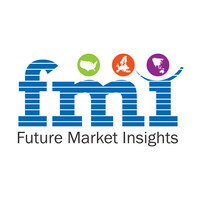Rising Applications in Drug Synthesis Surge Revenues in the Furfyl Alcohol Market. FMI Tracks Growth Patterns in 35+ Countries.
Furfuryl alcohol (C4H3OCH2OH), also known as 2-furylmethanol or 2-furancarbinol, is an organic compound containing a furan substituted with a hydroxymethyl group.
NEWARK, Del., July 17, 2024 /PRNewswire/ -- The global furfuryl alcohol market size is projected to be valued at USD 1192.5 million in 2024 and further increase at a CAGR of 5.9% during the forecast period. Worldwide sales of furfuryl alcohols are set to total USD 2115.5 million by 2034.
The foundry industry is expected to grow globally, particularly in developing countries, due to the demand for furfuryl alcohol, a compound made from renewable materials like corn cobs and sugarcane bagasse. This sustainable practice makes furfuryl alcohol an attractive option for various industries, including metal casting. Research and development activities will bring innovation and reduce costs, making it competitive in the industry.
Request Your Sample Report Now! https://www.futuremarketinsights.com/reports/sample/rep-gb-371
Furfuryl alcohol's strength-to-weight ratio and heat resistance make it suitable for composite materials. Its improved fire resistance and adhesion properties could open up new markets in the building and aerospace sectors. The compound's antibacterial and anti-inflammatory properties could also attract opportunities in the cosmetic and pharmaceutical industries. Government regulations and policies will influence the C5H6O2 sector.
Key Takeaways from the Market Report
- The global furfuryl alcohol market is set to reach USD 2115.5 million by 2034, with a CAGR of 5.9% in the forecast period.
- Based on source type, the corn cob raw material segment accounted for a market share of 88.8% in 2024.
- By applications, the foundry resin segment is estimated to lead with a market share of 83.3% in 2024.
- India is expected to record a CAGR of 8.8% between 2024 and 2034.
- Sales in China are predicted to rise at a CAGR of 6.6% through 2034.
How is Increasing Adoption in Wood Preservation Affecting Furfuryl Alcohol Market?
The introduction of 'furfurylation' technique for wood processing is propelling sales in the market. Rapid urbanization, expansion of residential and commercial sectors, along with increasing sales of home décor and wood furniture are chief factors driving demand in the wood industry.
This technique is a chemical process by which commercial wood properties are enhanced using furfuryl alcohol as a low-viscosity modifying agent. It is used to modify the wood structure and chemistry to make it less susceptible to biodegradation and chemical attack.
The polymerization process within the wood system has been touted as an eco-friendly and green alternative for conventional use of toxic compounds such as copper, salt, chromium, and arsenic. Furfurylated woods are non-toxic materials and are suitable for internal and external applications where aesthetic characteristics are required.
This process improves the hardness and durability of wood, making it completely resistant to termite attacks. In addition to this, it reduces the moisture content in wood and increases dimensional stability, thereby improving reduction in anisotropy with no effect on bending properties.
Further, wood furniture manufacturers are increasingly adopting this technique to improve elasticity, flame retardancy, dimensional stability, lower water consumption, tensile strength, hardness, and other mechanical properties.
Backed by these factors, sales of furfuryl alcohol in the wood and construction sector are projected to gain traction over the assessment period.
"Several end-use industries are finding applications for C5H6O2. Manufacturers are creating strategic alliances to maintain a steady demand for the compound," Says Nikhil Kaitwade, Associate Vice President at Future Market Insights (FMI).
Who is Winning?
Industry giants including China XLX Fertilizer Ltd., Aurus Specialty Company Limited, Hongye Holding Group Corporation Limited, and Xingtai Chunlei Furfuryl Alcohol Co., Ltd. are investing in research and development to improve production efficiency. They are exploring new uses for furfuryl alcohol, exploring new market niches and revenue streams.
Competitors are exploring bio-based resources and recycling furfuryl alcohol from foundry waste streams to minimize environmental impact and manufacturing costs. Expanding their reach in developing countries and novel markets through strategic alliances with foundry businesses can ensure demand and new applications. Organizations must maintain high-quality products, provide excellent customer service, and uphold safety and environmental requirements to maintain their market presence.
A Few Key Players-
- Aurus Specialty Company Limited, headquartered in Bangkok, is an export-oriented business that commenced the commercial production of Furfural and Furfuryl Alcohol in November 1990. It specializes in agro-waste processing and is a predominantly export-oriented industry to produces specialty chemicals.
- DynaChem Inc., headquartered in Illinois, is one of the leading domestic producers of aromatic sulfonic acids, industrial resins, and specialty chemicals. Their primary focus was on products and services for the metal casting industry. The company presently serves various sectors including adhesives, electronics, paints and coatings, reinforced composites, and others. They have achieved consistent growth through robust consumer partnerships and by providing custom-formulated products through consumer-specific solutions.
Get the Insights You Need – Connect with Sales to Secure Your Copy of Report: https://www.futuremarketinsights.com/checkout/371
Leading Furfuryl Alcohol Market Players
- China XLX Fertilizer Ltd.
- Aurus Specialty Company Limited
- Hongye Holding Group Corporation Limited
- Xingtai Chunlei Furfuryl Alcohol Co., Ltd.
- Zhucheng Taisheng Chemical Co., Ltd.
- Zibo Donghai Industrial Co., Ltd.
- DynaChem, Inc.
- International Furan Chemicals B.V.
- Silvateam S.p.a.
Furfuryl Alcohol Market - Category-wise Insights
Why is Corn Cob Raw Material Considered a Highly Sought-after Source?
Based on the source type, demand for corn cob raw material is expected to rise at a considerable pace in the forthcoming years. This material is one of the most consumed raw materials for the production of furfural and furfuryl alcohol.
Growing demand for sustainable alternatives in the chemical industry is boosting sales in this segment. Lignocellulosic agricultural wastes are considered as an alternative source of renewable raw materials.
Liquors with high content of hemicelluloses derived from corn cobs are treated with sulfuric acid and hydrochloric acid as catalysts to facilitate furfural production. Owing to these factors, sales in this segment are projected to remain high over the forecast period.
Which is the Primary Furfuryl Alcohol Application?
In terms of applications, sales in the foundry resins segment are projected to account for 83.3% of the total market share in 2024. Increasing adoption of furfuryl alcohol in the production of furan resins used for corrosion and heat-resistant materials in the foundry industry is expected to augment the growth of the market.
Furfuryl alcohol is widely adopted in binders used for regular furan no-bake systems. Increasing production in the metal casting industry is leading to the expansion of the foundry industry, thereby propelling sales.
Rapid urbanization in India, China, Japan, and Brazil is boosting the production of manufacturing molds, which is expected to continue boosting sales in this segment over the assessment period.
Key Segments of Market Report
By Source Type:
Based on source type, the sector is divided into sugarcane bagasse raw material, corn cob raw material, and others.
By Applications:
Furyfuryl alcohol has applications in corrosion inhibitors, foundry resins, solvents, and others.
By Region:
The sector is spread across North America, Latin America, Western Europe, South Asia, East Asia, Eastern Europe, and the Middle East and Africa.
Authored By
Nikhil Kaitwade (Associate Vice President at Future Market Insights, Inc.) has over a decade of experience in market research and business consulting. He has successfully delivered 1500+ client assignments, predominantly in Automotive, Chemicals, Industrial Equipment, Oil & Gas, and Service industries.
His core competency circles around developing research methodology, creating a unique analysis framework, statistical data models for pricing analysis, competition mapping, and market feasibility analysis. His expertise also extends wide and beyond analysis, advising clients on identifying growth potential in established and niche market segments, investment/divestment decisions, and market entry decision-making.
Nikhil holds an MBA degree in Marketing and IT and a Graduate in Mechanical Engineering. Nikhil has authored several publications and quoted in journals like EMS Now, EPR Magazine, and EE Times.
Have a Look at Related Research Reports of Chemicals & Materials
Rising demand for alcohol ethoxylates across diverse end-use industries such as home & personal care, oil & gas, and pharmaceuticals is driving the growth of the alcohol ethoxylates market.
The plasticizer alcohols market is expected to witness a steady growth during the forecast period, owing primarily to the steady growth in demand for plasticizers driven by the corresponding growth in end use industries.
The octyl alcohol market size is projected to be worth USD 6.7 billion in 2023. The market is likely to surpass USD 8.9 billion by 2033 at a CAGR of 2.9% during the assessment period 2023 to 2033.
The market is expected to register a CAGR of 3.7% by garnering a market value of USD 338.8 million by the end of 2033. As of 2023, sales of isooctyl alcohol are expected to be valued at USD 235.6 million.
Europe polyvinyl alcohol industry is set to be valued at USD 829.7 million in 2024 and is projected to reach USD 1,418 million by 2034. The sector will likely witness a modest CAGR of 5.5% over the forecast period 2024 to 2034.
The global renewable methanol market share is slated to expand at a CAGR of 6.6% during the forecast period surpassing USD 398.1 million by 2033.
The ethanol market growth is anticipated to increase from USD 114.02 billion in 2023 to USD 178.78 billion in 2033, with a CAGR of 4.6% between 2023 and 2033.
The rising demand for solvent-free and bio-based hot melt adhesives across various end-user sectors is creating lucrative hot melt adhesives market opportunities. These adhesives offer environmental benefits and meet the growing preference for sustainable solutions, driving their adoption in packaging, woodworking, automotive, and other industries.
The driveline additive market revenue is estimated to be valued at USD 9.3 billion in 2023. The market is expected to reach USD 15.2 billion by 2033, developing at a CAGR of 5.1%.
The global alumina trihydrate market is likely to reach a valuation of USD 5,324.6 million in 2023. From 2023 to 2033, it is projected to register significant acceleration at a positive CAGR of 7.7%.
About Future Market Insights (FMI)
Future Market Insights, Inc. (ESOMAR certified, recipient of the Stevie Award, and a member of the Greater New York Chamber of Commerce) offers profound insights into the driving factors that are boosting demand in the market. FMI stands as the leading global provider of market intelligence, advisory services, consulting, and events for the Packaging, Food and Beverage, Consumer Technology, Healthcare, Industrial, and Chemicals markets. With a vast team of ~400 analysts worldwide, FMI provides global, regional, and local expertise on diverse domains and industry trends across more than 110 countries.
Contact Us:
Future Market Insights Inc.
Christiana Corporate, 200 Continental Drive,
Suite 401, Newark, Delaware - 19713, USA
T: +1-845-579-5705
For Sales Enquiries: sales@futuremarketinsights.com
Website: https://www.futuremarketinsights.com
LinkedIn| Twitter| Blogs | YouTube
Logo: https://mma.prnewswire.com/media/1197648/3531122/FMI_Logo.jpg




Share this article